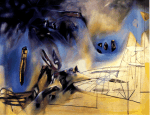 ROBERTO MATTA, 1911 - 2002 ... RIP
ROBERTO MATTA, 1911 - 2002 ... RIP Chilean painter, printmaker and sculptor Roberto Matta - last of the surrealists - has died in Civitavecchia near Rome at the age of 91.
"Matta replaced the repressed Microcosm with the unobtainable macrocosm." Roberto Matta was born in Santiago, Chile in 1911 and was educated there at the College of the Sacred Heart and at the Catholic University, graduating in 1931 with a degree in Architecture. In 1936 Matta went to Paris and found employment as a draftsman with Le Corbusier.
During this period, he met Pablo Neruda and Federico Garcia Lorca.
Through Lorca, he met Dali, and through Dali he met Andre Breton who was impressed enough to buy some of Matta's drawings. In 1938, Matta joined the Surrealist group and participated in the International Surrealist Exhibition in Paris.
At the outbreak of war in Europe, Matta , along with the other painters most associated with the movement, came to New York. His first one-man show was given at the Julian Levy Gallery in 1940. Max Ernst, whose name is inseperable from Surrealism, and Roberto Matta began an association with Peggy Guggenheim's influential New York gallery, Art of the Century, in 1941.
Matta was a friend of Jackson Pollock during this time and was a very strong influence on the art of his close friend Arshile Gorky, whose work is said to have been a bridge between European Surrealism and what a new generation of American Surrealists were to make of it.
Andre Breton considered Gorky to be the most important of the American recruits to Surrealism. Much younger than most of his colleagues, Matta endeavored to make a place for himself by extending the scope of Surrealism.
His works, in their structure, sometimes suggest his Architectural training, yet the landscapes of his mind often depict other, impossible worlds. As Nicholas Calas said:
"Matta replaced the repressed Microcosm with the unobtainable macrocosm."
Matta parted from the Surrealist group and returned to Europe in 1948, (he was re-integrated in 1959) settling first in Rome and then in Paris.
The works of Roberto Matta can be described as surrealistic cartoon type drawings.
In the early works the colours are lighter and the objects often poorly outlined. The random forms he saw emerging developed into human and mechanistic forms, sometimes defined and contained within geometric architectures.
The illustrations were full of irony and often including erotic scenes. With time the figures became more clearly outlined and the colours more brighter and the background darker. In later works Matta again went for less defined objects
His works hang in many of the world's most important museums, and interest in his art continues to grow.
In a world where the behaviour of nations and national leaders are increasingly bizarre and unreal, Robert Matta's unique vision will be sorely missed.
